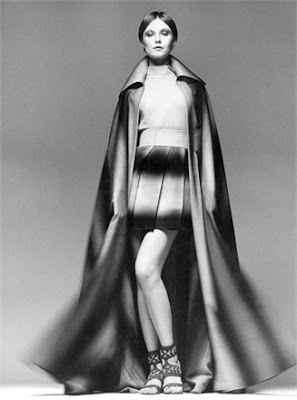 |
| 1938 |
 |
| Tony Kent 1968 |
 |
| Elisabetta Catalano 1970 |
 |
| David Bailey 1970 |
 |
| Barry Lategan 1971 |
 |
| Barry Lategan 1971 |
 |
| Gian Paolo Barbieri 1974 |
 |
| Francois Lamy 1978 |
 |
| David Bailey 1979 |
 |
| Barry Lategan 1979 |
 |
| Albert Watson 1990 |
 |
| Juergen Teller 1997 |
All throughout fashion and costume history, capesand mantles of every sort have played a role in the clothing of every population. In the Victorian age,capes and wraps, sometimes embroidered or with paisley motifs for women, were alternated withblack, fur-lined capes for men.
From 1910, the cape began to come into its moment.Paul Poiret was definitely one of the first tailors responsible for the transformation of the cape, playing with its shape in various forms. In 1911 he created a velvet Batik with colorful designs and swirls in the muted tones typical of the era, and trimmed with fur at the collar and cuffs. It was Poiret who made the first ethnic-inspired cape, which he called Tanger, in 1919. In the early '20s, the American actress Estelle Winwood was depicted in a portrait wearing a chiffon gown and a matching cape by Harry Collins.
Jeanne Lanvin had a long tradition in capes. In 1926, she created one of the most beautiful models, shaped like an egg, in black velvet with white fur trim and embroidered with pink and silver beads. And in 1935, a multi-layered cape in organza strips that got increasingly wider and then trimmed with embroidery. And another in 1937, floor-length, with a geometrical beaded embroidery at the back. Just a look at the Gazette du Bon Ton of that era and you'll find various models, also in fur, always by Jeanne Lanvin.
Mainbocher remains famous for the white cape with silver fox trim in the portrait by Steichen. We're in 1932. And in the tradition of photography and fashion, another unforgettable piece is the short, quilted, red cape by Elsa Schiaparelli, photographed by the Baron de Meyer, and the group of models dressed in long satin capes, in ecclesiastical style, inspired by the paintings of Goya, in a photo taken in 1936, by Cecil Beaton. In 1934 Gilbert Adrian made a made-to-measure golden, hooded cape for Joan Crawford.
Elsa Schiaparelli often worked with the cape. From her Astrologie series in the '30s: the red satin cape with an embroidered sun on the back, and the new, transparent Glass Cape, made from Colcombet's Syntethic Rhodophane, a new synthetic material that was quite avant-garde in those years, has become an iconic piece in the history of fashion.
One of the most eccentric figures of that period was the Marquise Luisa Casati, who became famous for her capes and her extravagant, mysterious looks. She was dressed by the likes of Paul Poiret, Mariano Fortuny, and Erté - becoming the muse for many artists. Her long affair with Gabriele D'Annunzio rendered even more alluring and dark, as did her habit of walking with leashed panthers and other exotic animals.
As a theatrical item, a piece of clothing worthy of a grande soirée, the cape found its place in the collections of Madame Grès in 1947, most notably a long grey cape trimmed in fur, as well as a glimmering, blue silk creation byBalenciaga in 1948.
The drama of the cape began to slowly diminish in the 1950s, and it became more sophisticated, as demonstrated by the photos by Henry Clarke in 1955: a small,sealskin cape by Balmain, worn over a slim-fitting, belted dress.
Again, in that same era, the cape transformed into a romantic accessory: in1955 Jacques Fath created a white, three-layer, pleated cape worn over an evening gown. In these years, the cape became replaced by stoles, large or small, almost always in fur.
Then in the '60s, the cape took on a more playful air, with a young, carefree image. In 1965, Emilio Pucci created big, colorful capes with his signature patterns and hoods. Lord&Taylor made a hooded model in gold brocade in 1966 and the next year, Yves Saint Laurent created a black velvet cape worn with a ruffled shirt and silver buckled shoes. Laurent, in 1970, looked towardsMorocco for inspiration and his hooded capes were elaborately adorned. It was again Yves Saint Laurent who designed the wool cape that Marguerite Yourcenarwore when she entered the Accademie Francaise in 1981.
In 1969 Emanuel Ungaro made a cape in sangallo with huge ping-pong sized balls as trimming, worn with shorts and a metal brassiere, which was rendered by Bert Stern in a stupendous photo. And in the '70s, Giampaolo Barbieri immortalizedMirella Petteni while wrapped in cape by Lancetti; in 1971 Jane Birkin, dressed in a cape and shorts by Luba was photographed by Lichfield.
In 1970, Pierre Cardin designed capes in jersey tweed of with jacquard designs that wrapped around the head, with an oval opening at the face. Biba createdfur capes and Walter Albini made them in black wool. The ethnic chic phasebegan in 1976 and Parkinson was the photographer of the moment. Iman was photographed numerous times by him while traveling in the East with gorgeouswhite capes.
At the beginning of the '80s, capes were still being featured, but only in collections by Japanese designers like Rei Kawakubo for Comme des Garçons orYohji Yamamoto. In the '90s, they appeared in very few collections: Giorgio Armani made a few evening capes in velvet and silk, and there were some in the Haute Couture collections by John Galliano and Jean Paul Gaultier.
They appeared sporadically in a few collections, like an adorned, embroidered cape from the last collection by Alexander McQueen, or those from a few young designers like Erdem.
Capes are alluring, and they leave the body more freedom of movement. They arefeminine and fascinating. And as it always happens in fashion, they'll have acomeback. Sooner or later.
Franca Sozzani
Sem comentários:
Enviar um comentário